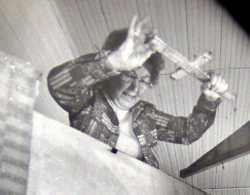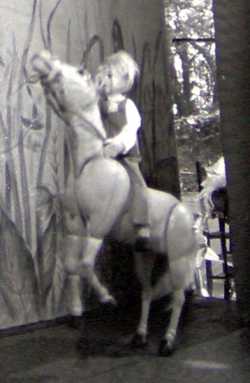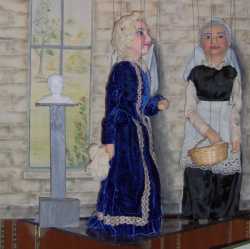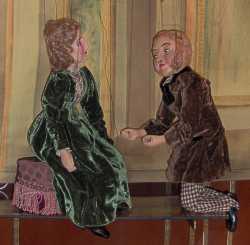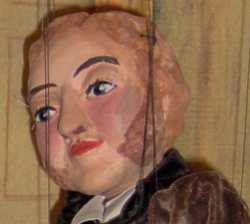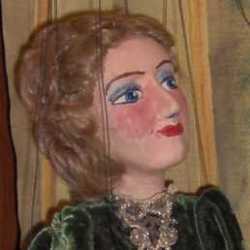
|

|
Waco's Puppet LadyBy: Terri Jo Ryan, Waco Tribune-Herald April 30, 2007 |
|
Although she never married nor had children of her own, Doris Goodrich Jones of Waco was the mother of hundreds of “little people” — the puppets she created to spin marvelous tales of wisdom and wonder. She shared her home at 326 N. 14th Street (now part of the Freeman Center’s housing block for folks undergoing drug rehabilitation) with character like The Fiddling Cowboy, Monkeyshines the Brazilian monkey, Senorita Lolita, Sealeg Sailor, Jimmie Scarecrow and an assortment of clowns, dancers, elves and a menagerie of musical instrument-playing critters.
When Jones arrived in local schools in the 1930s, 40s and 50s, she mesmerized her young audiences and inspired many to go home and make their own puppet theaters. Waco’s “Puppet Lady” was born April 2, 1902, in Temple, to William Goodrich Jones of New York City and Zollie Luther of Palmyra, Mo.
According to the oral history Doris Jones provided the Institute for Oral History at Baylor University, when the young Doris came home from classes at age 7 with a “sweetheart,” she was taken out of public school and put into private education. Her family moved to Waco in the late 1920s. Jones’ college career included earning a bachelor of music degree from Southern Methodist University, and coming to Baylor University for a bachelor of education degree and her teaching certificate. In the early 1930s, she taught at an elementary at Gatesville in addition to giving drama and music instruction at the Methodist Children’s Home in Waco. But the course of her life was set after many summers spent in Chautauqua, N. Y. with relatives — especially two spinster aunts who prized independence and inquiry over conventionality. Chautauqua was, and remains, the summer resort community that plays host to an internationally-renowned non-profit adult education center. And Jones discovered her passion for the puppetry arts there.
But in Waco, during the school year, she made a humbler wage: Schools charged children a nickel each to attend her shows, and she split the proceeds with the campus, keeping 60 percent as her fee. As the years went on, that fee grew to a dime and then a quarter.
|
As her shows caught on with local schools and then campuses throughout Texas and neighboring states, her cast of characters grew as fast as the number of her sets. She travelled with Grace Gooda, the daughter of Southern Baptist missionaries to Brazil, in a panel truck W.G. Jones bought for $800 in 1939 for them to use in hauling around the “Doris Goodrich Jones Puppet Theater.” (Gooda died at one of the shows in 1957, at Sanger Elementary, of a heart attack).
Jones and Gooda also performed at the Sears in Dallas from Thanksgiving until Christmas, 1942 through 1944, as the star attraction at Toyland. They employed a range of puppetry techniques: hand puppets, rod puppets, marionettes and even shadow puppets in their storytelling. The Puppet Lady created biblical character hand puppets and marionettes for her Sunday School at Central Presbyterian Church, at no charge. And she never charged for performances of her humane education show, in which she taught about compassion towards animals and always ended with the plea: “Be sure to give your pet plenty of water and to give him a dry, warm place in the winter and a cool place in the summer.”
She also taught puppetry at Chautauqua for more than 20 years. This summer, officials there will host an exhibit of some of her many creations, as well as produce several of her puppet plays for new generations, said Cooper, who is assistant professor of piano in the music school at Baylor. Jones continued to perform well into her 80s. In the early 1990s, Jones moved back to her native Temple, where she died on July 9, 1993. She is buried in the family plot with her parents and an infant brother at Hillcrest Cemetery of Temple. Cooper’s daughter, and Jones’ namesake, is the Rev. Dorisanne Cooper senior pastor of Lake Shore Baptist Church of Waco for five years. She recalled the puppeteer as a grandmotherly figure for the family, the one who hosted the major family gatherings. ____________________ |
|
Return to Moments in Time home page |
|
